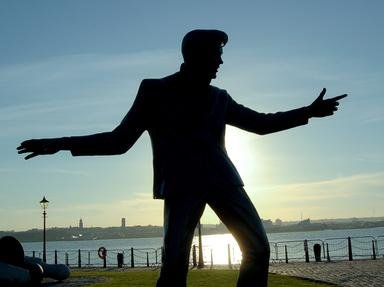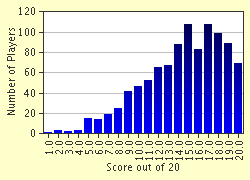Quiz Answer Key and Fun Facts
1. Leading the pack of hits for 1967 was a monster. Number One for seven weeks, it spent 12 of its 15 Hot 100 weeks within the cozy confines of the top ten, earning 1774 points in the process. I'm sure you can name it with help from these lines!
"I thought love was more or less a givin' thing
Seemed the more I gave the less I got
What's the use in tryin'
All you get is pain
When I needed sunshine I got rain"
2. "The time has come for closing books and long last looks must end
And as I leave I know that I am leaving my best friend"
For a record which only ranked number two for 1967, it sure racked up impressive statistics - 1435 points based on 17 Hot 100 weeks, 13 in the top 10 and five weeks at Number One. What was the song's title?
3. "Listen mister, can't you see I got to get back
To my baby once more"
What song does this lyric come from? It was ranked at number three for 1967 with 1211 points based on four weeks at Number One and a 16 week Hot 100 presence.
4. "You know that it would be untrue
You know that I would be a liar
If I was to say to you
Girl, we couldn't get much higher"
With 17 charting weeks, three weeks at Number One and 1198 points, this record rolls into the fourth spot of 1967 rankings. What was this song... it is now a genuine classic?
5. "Who's peekin' out from under a stairway"
"Who's bending down to give me a rainbow"
"Who's tripping down the streets of the city"
"Who's reachin' out to capture a moment"
The singers of this hit have given us these four tips as to the identity of the song's subject. Your job is to name that person. It should be relatively easy... this was the fifth ranked song of 1967 with 1186 points having spent four weeks at Number One during its 14 week chart life. It's also been recognized by BMI as the 61st most played song of the 20th Century.
6. Ranked number six for 1967 was another genuine million selling Gold Record that charted for 14 weeks on its way to four weeks at Number One and an accumulation of 1183 points. It was a narrative dealing with events at places like Choctaw Ridge and the Tallahatchie Bridge. What song was it?
7. The record ranked number seven exploded onto the charts. Debuting inside the top 40 where it spent the rest of its chart life of 12 weeks, it was also Number One for four weeks gathering 1136 points in the process. It was the second Number One for The Monkees in 1967 and the second biggest hit of their recording careers. BMI also lists it as the 65th most played radio song of the 20th Century. With that information, what song are we talking about?
8. "Imagine me and you, I do
I think about you day and night, it's only right
To think about the girl you love and hold her tight"
This song finished 1967 ranked number eight, earning 1119 points based on a 15 week chart life, three of those at Number One. What was the title of this uplifting song?
9. "I know I stand in line until you think you have the time
To spend an evening with me
And if we go someplace to dance I know that there's a chance
You won't be leaving with me"
These lines come from one of the more endearing male-female duets from the rock era. What was the title of this song that was Number One for four weeks in 1967 and earned sufficient points, 1111, to rank as the ninth biggest hit of the year?
10. The 10th ranked song for 1967 was "I Heard It Through The Grapevine". "Wait a minute," you might implore... "That was a 1968-69 song by Marvin Gaye". You'd be absolutely right but his was a cover of an earlier version that was a pretty big hit in its own right. Who recorded the 1967 version, a record that sat at Number Two for three weeks during its 17-week chart life?
11. The Strawberry Alarm Clock topped the charts for a week in 1967 with one of the premiere songs of the psychedelic era, as brief as that era was. It featured trippy music and lyrics much more cryptic than the norm. Here's a sample of those lyrics from the 11th ranked song of the year with 1053 points, then you name it.
"To divide this cockeyed world in two
Throw your pride to one side, it's the least you can do
Beatniks and politics, nothing is new
A yardstick for lunatics, one point of view"
12. The record that ranked number 12 for 1967 was not a Number One hit, peaking for only one week at Number Two. However, with a 16-week span in the Hot 100, 14 of them within the top 40, it claimed 1035 points and almost a coveted top 10 spot in these rankings. It was performed by a familiar voice now taking a turn as a solo artist. What song is it? Here's a lyrical hint.
"I love you baby, and if it's quite alright
I need you baby to warm the lonely night
I love you baby trust in me when I say
Oh pretty baby, don't bring me down I pray.
Oh pretty baby, now that I found you, stay."
13. Every generation of teenagers seems to invent their own words not permitted for adult use. So, as my mother might say, "23 skidoo" to you and recall this term that became the "bee's knees" in 1967 when the Young Rascals sang a "swell" song about it. The song became the 13th ranked of the year with 1018 points, largely due to four weeks at Number One. What song am I talkin' about?
14. "Now when you're feelin' low and the fish won't bite
You need a little bit o' ____ to put you right
You gotta make like you wanna kneel and pray
And then a little bit o' ____ will come your way"
The Music Explosion only had one big hit - this one! By staying in the Hot 100 for 16 weeks, peaking at Number Two for two of them, it gathered 1010 points, good for 14th place in 1967 year-end rankings. What was the "little bit" of something that they felt would elevate your life?
15. "I saw her sitting in the rain, raindrops falling on her
She didn't seem to care, she sat there and smiled at me
And I knew (I knew, I knew, I knew, I knew)
She could make me happy (happy, happy)
Flowers in her hair, flowers everywhere"
Peace and love, man! What was this song? It didn't quite make Number One, stalling at Number Two for a couple of weeks, but with 16 weeks in the Hot 100, it scored 991 points, enough to rank 15th in the year-end recap. I'll tell you the Cowsills recorded it.
16. Although this was another song that could only peak at Number Two in 1967 and finished the year ranked number 20 based on chart performance, it has endured to become a classic love song. The BMI study in 1999 discovered that it was the second most played radio song in the 20th Century - only "You've Lost That Lovin' Feelin'" was played more frequently. Let's see if you can identify it with this clue from the lyric.
"What makes you think love will end
When you know that my whole life depends
On you (on you)"
17. "Maybe you think that love would tie you down
You ain't got the time to hang around
Maybe you think that love was made for fools
So it makes you wise to break the rules
Oh little girl, in that case I don't want no part
That would only break my heart"
This song peaked at Number Four on the Hot 100 during its 15-week chart life and based on its Billboard action, finished 1967 as the 23rd ranked song. It was performed by an R&B group that had been around for seven years and this would be their second biggest hit up that point, only their debut single "Shop Around" rating higher. With all that going for you, what hit was this?
18. "Nothing you can sing that can't be sung
Nothing you can say but you can learn
How to play the game... it's easy"
Because this record only stayed on the charts for 11 weeks, the best that the Beatles could do in the 1967 recap was this number 36 ranked hit even though it was one of their 18 Number One hits. It would be the lowest ranking hit they would ever have for their top song of a year. Knowing that the song begins with a country's national anthem, can you name it?
19. "Your eyes, I say your eyes may look like his
Yeah, but in your head, baby, I'm afraid you don't know where it is"
This song was extraordinarily popular in 1967 but, for some reason, it only placed at Number Five on the charts and number 51 in this recap. Can you get it?
20. In 1967, the song that won five Grammy awards could only make it to Number Seven on the Billboard Hot 100 and the 70th ranking position for the year-end recap. Jimmy Webb wrote the lyrics - see if you can ascertain the title from this segment of Webb's work.
"If you'll hold my hand we'll chase your dream across the sky
For we can fly, we can fly"
Source: Author
maddogrick16
This quiz was reviewed by FunTrivia editor
Bruyere before going online.
Any errors found in FunTrivia content are routinely corrected through our feedback system.

